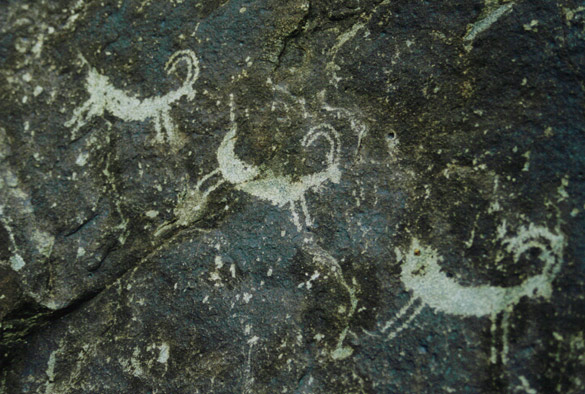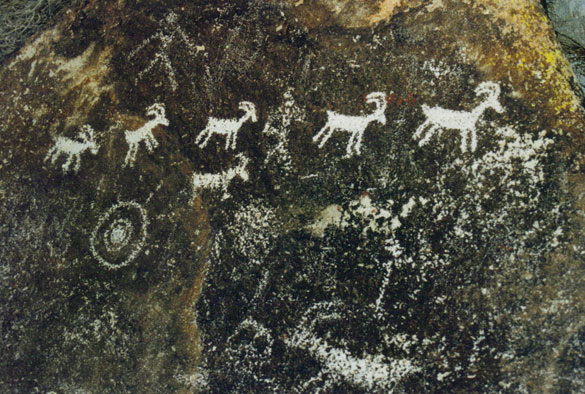South Nevada rock art, part 3
We continue this short collaborative series with guest contributor Loretta who is kindly sharing her observations and photographs of some of the rock art found in her home region in the southwest US. (Please see part 1 and part 2.)


Grapevine Canyon near Christmas Tree Pass has one of the largest numbers of petroglyphs in one place in S. Nevada, and one of the most accessible. The pass is well marked, just a few miles off the main highway west of Laughlin, which is on the Colorado River. From a parking lot, you trudge along a sandy dry river bed until huge dark boulders rise before you, framing the canyon. An astonishing number of petroglyphs completely cover the boulders. As you turn to look back down the river bed, a broad vista opens up, taking your eye down toward the Colorado River and beyond to the rugged mountains of Arizona.
The dry river bed has its origins near the top of the canyon, where reeds and wild grapevines announce the presence of water. Bits of green edge the trickle of water coming down until it disappears under the boulders, hiding its life-giving essence from the harsh desert sunlight.
The petroglyphs themselves are remarkably well-preserved, with only a few having been defaced. One can imagine the good times enjoyed by the ancient travelers in this gathering place as they shared stories and carved pictures as illustrations to leave for others to find – could they have imagined us, now, wondering and puzzling over them?
A fascinating related link: How to make a petroglyph (thanks to gabriolan)
All photographs © Loretta
See also: part 4
May 15, 2010 in Rock Art & Archaeology by Marja-Leena
They really are very beautiful. I don’t think we can really imagine the people who painted them except in our understanding that they knew themselves to be part of a sacred landscape.
I wonder how easy, or otherwise, it would be to carve rocks?
Wouldn’t it be lovely to be able to do so and to leave something permanent behind, even if it does become mossy and covered in lichen?
What would you carve, I wonder?
Susan, it’s wonderful to have these fabulous marks to look at long after to remind us of their presence in these places, almost like their spirits are still alive there. That’s what fascinates me about these ancient sites around the world, as if we could touch across time.
Julie, did you look at the link on how to make petroglyphs? Imagine having to find the right stone and sharpen it to make the tool, then carve the rock. That took knowledge and skill. And so permanent compared to basket weaving etc. Hmm, I might carve one of the animals in the area that were killed in the hunt as a sign of gratitude, or the sun, moon, stars that gave me light and a sense of a great Spirit.